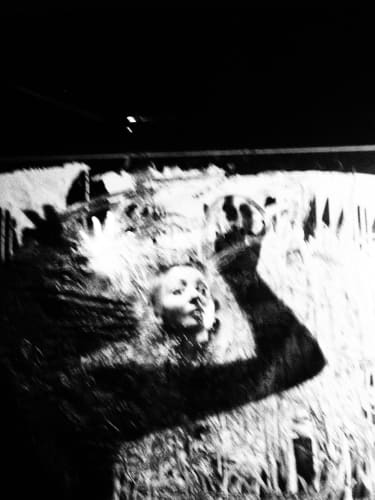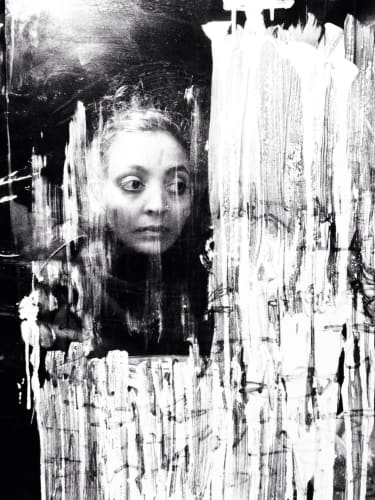It happened…did not happen…could have happened…
The victor, they say, writes the history, and so truth becomes twisted, buried even, in the cause of self-justification, self-aggrandisement. And yet, all cultures have their stories, their foundation myths, with which they seek to explain themselves to themselves and to the world at large. There’s no harm in that. Is there?
Seeta Patel’s new show, Not Today’s Yesterdays, (developed with choreographer, Lina Limosani, and visual dramaturg, Dagmara Gieysztor) seeks to explore the threat of histories being ‘whitewashed’ by the powerful. This latter term, Patel is at pains to explain in the post-show discussion, is not intended to point the finger solely at white people and white culture. This important truth (evidenced by even a cursory look at contemporary politics in say Turkey or India) does not alter the fact that American and British imperialism feature (quite rightly) in Not Today’s Yesterdays.
As we enter, a lone dancer (Seeta Patel) is frozen in pose; a statue set on an unimposing platform. Her back to us, she faces what, in this subdued lighting, appears to be a silvered screen, but will be revealed as clear perspex. The pose is held for some time after we settle, before the story begins, quietly, comfortingly.
Once upon a time…
In a faraway land…
We hear, in classic bedtime story style, of ‘rivers of chocolate’ and ‘rain like diamonds’ (rain will become less reassuring as the night wears on).
To begin with, the lighting is very restrained, the dancer all but in silhouette. It would be easy to lose an audience this early in the show—small movements, barely lit. However, Seeta Patel—an outstanding practitioner of the classical South Asian dance form, Bharatanatyam—moves her hands and arms (the only elements properly lit at this point) with such expressive grace that the audience are immediately captivated, leaning forward in their seats, peering through the gloom, so that their eyes can better absorb the mesmerising patterns she weaves.
Descending from the platform, the story (told in pre-recorded voice, to which Patel intermittently lip-synchs) she moves through mountain ranges of soft, clear plastic, leading us towards a plait of “hair”, hanging from the ceiling. Those of European heritage may think church bell-rope or, more likely, Rapunzel. However, hair has cultural import in civilisations across the globe.
As she completes the plaiting, Patel regales us with the story of the hair—how it protects and guides. This story is ‘both a reservoir and a mirror’. The choreography with the plait as prop is lovely (we could bear more of this, especially given hair’s significance in the tale).
Like a giant goddess, the dancer moves mountain ranges with ease, reconfiguring the world according to her desires, taking us to another culture, another time. The stories are passed on. ‘There wasn’t a story that was ever forgotten,’ we are told, fearing for the truth of this.
Now another element enters the story—strangers, from boats ‘loaded but hungry’. There is trade, there is shared exchange and benefit. Patel’s hands fold over one another in a gesture of agreement, of mutuality, of trust. We know it cannot last.
Suddenly, the mood changes—the soundtrack here, a mash-up of US presidential addresses. Patel, formerly in more traditional, South Asian attire, is now reduced to vest and shorts—a stripping away of indigenous culture, of self-sufficiency. The dancer, trapped behind the perspex wall, is pressed down, shut in (or out) and silenced (mouthing words we cannot hear). Finally, she lies prone and still.
Now, as the gentle rainfall becomes interspersed with the menace of thunder, she raises a simple vessel—a jug. Is she begging? offering? annointing? White liquid flows from the vessel, dribbling in lines down the screen, like opaque rain on a window. Wildly, the dancer smears the paint across the screen, obscuring the entire barrier—she cannot get through to us, nor can she/we see what is on the other side. The whitewashing of history.
Patel wipes clear a small window, just wide enough for her head. To a violent musical soundtrack, an impressive shadow-play ensues; Patel’s cleverly lit movements creating a beast (highly evocative of Ridley Scott’s Alien). The creature toys with her, patronising; sometimes seeming to soothe, otherwise threatening to devour. It is the most powerfully dramatic section of the show. Stunning.
As we move towards the finale, the clear plastic props are built into a dress (the Empress’s new clothes). With jerky, mechanical, reptillian motions, we now hear what is, in essence, the British imperialist version of history. The plastic garment provides a deliciously jarring accompanment to the structured awkwardness of the movement (along with a magnificently bizarre operatic contribution from the recorded voice of Wendy Nieper).
The telling now is angry and yet insecure—as if fearing the truth will show through this transparent fabrication. The language becomes is brutal and on-the-nose; no room for poetry, the listener must be ear-bashed into acceptance.
Finally, the plait, severed and dyed white, a culturally-appropriated remnant, is at first tamed then executed. Is this story lost, forgotten, erased?
We are offered no guidance. The rivers of chocolate have dried up. The hour has passed before we know it.
The interplay of Patel’s classical form with Limosani’s contemporary choreography makes a perfect partnership for the telling of this old/new tale. Guy Hoare’s lighting provides some spectacular moments and will no doubt, with a more sophisticated rig than the Lowry studio offers, make an even greater contribution to the production.
While this is a very fine team effort, in the end its success (and it is an unequivocal success) hangs on Seeta Patel’s bewitching talents. The arms, the hands, the fingers, the angle of a foot or tilt of the head, and the eyes—always the eyes—saying, ‘watch me, “listen” to what I’m telling you, I’m speaking to you alone.’
An unmissable treat.

